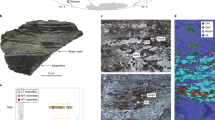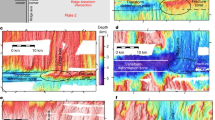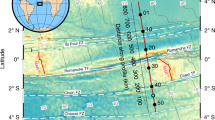Abstract
Oceanic transform faults, connecting offset mid-ocean spreading centres, rupture quasi-periodically in earthquakes up to about magnitude M 7.0 that are often preceded by foreshocks. In addition to seismic slip, a large portion of slip takes place as aseismic creep, which likely influences initiation of large earthquakes. Although oceanic transform faults are one of the major types of plate boundaries, the exact mode of slip and interaction between the seismic and aseismic motion remains unclear. Here we present a detailed model of the mode of slip at oceanic transform faults based on data acquired from a recent temporary deployment of ocean-bottom seismometers at the Blanco Transform Fault and existing regional and teleseismic observations. In the model, the crustal part of the fault is brittle and fully seismically coupled, while the fault in the mantle, shallower than the depth of the 600 °C isotherm, creeps partially and episodically. The creep activates small asperities in the mantle that produce seismic swarms. Both mantle and the crustal zones release most of the plate-motion strain during large-magnitude earthquakes. Large earthquakes appear to be preceded by a brief episode of shallow mantle creep, accompanied by seismic swarms, which explains the observation of foreshocks and shows that mantle creep likely influences initiation of large seismic events.
This is a preview of subscription content, access via your institution
Access options
Access Nature and 54 other Nature Portfolio journals
Get Nature+, our best-value online-access subscription
$29.99 / 30 days
cancel any time
Subscribe to this journal
Receive 12 print issues and online access
$259.00 per year
only $21.58 per issue
Buy this article
- Purchase on Springer Link
- Instant access to full article PDF
Prices may be subject to local taxes which are calculated during checkout




Similar content being viewed by others
Data availability
The OBS dataset is archived at the IRIS Data Management System (http://www.iris.edu). X9 is the network code for the Plate Boundary Evolution and Physics at an Oceanic Transform Fault System project32; 7D is the network code for the Cascadia Initiative Community Experiment – OBS component data33. Raw bathymetry data, used in Fig. 1 and Supplementary Fig. 1, are available from the authors.
References
Braunmiller, J. & Nábělek, J. Segmentation of the Blanco Transform Fault Zone from earthquake analysis: complex tectonics of an oceanic transform fault. J. Geophys. Res. Solid Earth 113, B07108 (2008).
Embley, R. W. & Wilson, D. S. Morphology of the Blanco Transform Fault Zone-NE Pacific: implications for its tectonic evolution. Mar. Geophys. Res. 14, 25–45 (1992).
Boettcher, M. S. & McGuire, J. J. Scaling relations for seismic cycles on mid-ocean ridge transform faults. Geophys. Res. Lett. 36, L21301 (2009).
McGuire, J. J. et al. Variations in earthquake rupture properties along the Gofar transform fault, East Pacific Rise. Nat. Geosci. 5, 336–341 (2012).
Roland, E., Behn, M. D. & Hirth, G. Thermal‐mechanical behavior of oceanic transform faults: implications for the spatial distribution of seismicity. Geochem. Geophys. Geosyst. 11, Q07001 (2010).
Boettcher, M. S., Hirth, G. & Evans, B. Olivine friction at the base of oceanic seismogenic zones. J. Geophys. Res. Solid Earth 112, B01205 (2007).
Lohman, R. B. & McGuire, J. J. Earthquake swarms driven by aseismic creep in the Salton Trough, California. J. Geophys. Res. Solid Earth 112, B04405 (2007).
Linde, A. T., Gladwin, M. T., Johnston, M. J. S., Gwyther, R. L. & Bilham, R. G. A slow earthquake sequence on the San Andreas fault. Nature 383, 65–68 (1996).
Roland, E. & McGuire, J. J. Earthquake swarms on transform faults. Geophys. J. Int. 178, 1677–1690 (2009).
Scholz, C. H. The Mechanics of Earthquakes and Faulting (Cambridge Univ. Press, Cambridge, 1990).
Francis, T. Serpentinization faults and their role in the tectonics of slow spreading ridges. J. Geophys. Res. Solid Earth 86, 11616–11622 (1981).
Kohli, A. H., Goldsby, D. L., Hirth, G. & Tullis, T. Flash weakening of serpentinite at near‐seismic slip rates. J. Geophys. Res. Solid Earth 116, B03202 (2011).
Reinen, L. A. Seismic and aseismic slip indicators in serpentinite gouge. Geology 28, 135–138 (2000).
Guillot, S., Schwartz, S., Reynard, B., Agard, P. & Prigent, C. Tectonic significance of serpentinites. Tectonophysics 646, 1–19 (2015).
Dziak, R. P. et al. Recent tectonics of the Blanco Ridge, eastern Blanco Transform Fault Zone. Mar. Geophys. Res. 21, 423–450 (2000).
Boettcher, M. S. & Jordan, T. H. Earthquake scaling relations for mid‐ocean ridge transform faults. J. Geophys. Res. Solid Earth 109, B12302 (2004).
Okal, E. A. & Langenhorst, A. R. Seismic properties of the Eltanin Transform System, South Pacific. Phys. Earth Planet. Interiors 119, 185–208 (2000).
Bird, P., Kagan, Y. Y. & Jackson, D. D. in Plate Boundary Zones (eds Stein, S. S. & Freymueller, J. T.) 203–218 (AGU, Washington DC, 2002).
McGuire, J. J. Seismic cycles and earthquake predictability on East Pacific Rise transform faults. Bull. Seismol. Soc. Am. 98, 1067–1084 (2008).
Sykes, L. R. & Ekström, G. Earthquakes along Eltanin transform system, SE Pacific Ocean: fault segments characterized by strong and poor seismic coupling and implications for long-term earthquake prediction. Geophys. J. Int. 188, 421–434 (2012).
McGuire, J. J. Immediate foreshock sequences of oceanic transform earthquakes on the East Pacific Rise. Bull. Seismol. Soc. Am. 93, 948–952 (2003).
McGuire, J. J., Boettcher, M. S. & Jordan, T. H. Foreshock sequences and short-term earthquake predictability on East Pacific Rise transform faults. Nature 434, 457–461 (2005).
McGuire, J. J., Ihmle, P. F. & Jordan, T. H. Time-domain observations of a slow precursor to the 1994 Romanche transform earthquake. Science 274, 82–85 (1996).
Abercrombie, R. E. & Ekström, G. Earthquake slip on oceanic transform faults. Nature 410, 74–77 (2001).
Wilson, D. S. Confidence intervals for motion and deformation of the Juan de Fuca Plate. J. Geophys. Res. Solid Earth 98, 16053–16071 (1993).
DeMets, C., Gordon, R. G. & Argus, D. F. Geologically current plate motions. Geophys. J. Int. 181, 1–80 (2010).
Pavlis, G. L., Vernon, F., Harvey, D. & Quinlan, D. The generalized earthquake-location (GENLOC) package: an earthquake-location library. Comput. Geosci. 30, 1079–1091 (2004).
Waldhauser, F. & Ellsworth, W. L. A double-difference earthquake location algorithm: method and application to the northern Hayward Fault, California. Bull. Seismol. Soc. Am. 90, 1353–1368 (2000).
De Rubeis, V., Loreto, V., Pietronero, L. & Tosi, P. in Modelling Critical and Catastrophic Phenomena in Geoscience (eds Bhattacharyya, P.& Chakrabarti, B. K.) 259–279 (Springer, Berlin Heidelberg, 2006).
Brune, J. N. Tectonic stress and the spectra of seismic shear waves from earthquakes. J. Geophys. Res. 75, 4997–5009 (1970).
Hanks, T. C. & Kanamori, H. A moment magnitude scale. J. Geophys. Res. Solid Earth 84, 2348–2350 (1979).
Nábělek, J., Braunmiller, J. Plate boundary evolution and physics at an oceanic transform fault system. International Federation of Digital Seismograph Networks https://doi.org/10.7914/SN/X9_2012 (2012).
IRIS OBSIP Cascadia Initiative Community Experiment - OBS component. International Federation of Digital Seismograph Networks https://doi.org/10.7914/SN/7D_2011 (2011).
Acknowledgements
The seismic stations for the project were provided by the Ocean Bottom Seismograph Instrument Pool (http://www.obsip.org), funded by the National Science Foundation (NSF). This research was supported by NSF grants OCE-1031858, OCE-1131767 and OCE-1737073. We thank the crews of RV Melville and RV Oceanus, OBSIP technicians and volunteers who contributed to data collection.
Author information
Authors and Affiliations
Contributions
J.L.N. and J.B. designed the study and collected the dataset. V.M.K. and J.L.N. created the seismicity catalogue. V.M.K. conducted the data analysis. All authors discussed results and contributed to the manuscript.
Corresponding authors
Ethics declarations
Competing interests
The authors declare no competing interests.
Additional information
Publisher’s note: Springer Nature remains neutral with regard to jurisdictional claims in published maps and institutional affiliations.
Supplementary information
Supplementary Information
Supplementary Figures, Supplementary Tables.
Rights and permissions
About this article
Cite this article
Kuna, V.M., Nábělek, J.L. & Braunmiller, J. Mode of slip and crust–mantle interaction at oceanic transform faults. Nature Geosci 12, 138–142 (2019). https://doi.org/10.1038/s41561-018-0287-1
Received:
Accepted:
Published:
Issue Date:
DOI: https://doi.org/10.1038/s41561-018-0287-1
This article is cited by
-
How transform fault shear influences where detachment faults form near mid-ocean ridges
Scientific Reports (2023)
-
Broad fault zones enable deep fluid transport and limit earthquake magnitudes
Nature Communications (2023)
-
Oceanic transform fault seismicity and slip mode influenced by seawater infiltration
Nature Geoscience (2021)
-
Connection between earthquakes and deep fluids revealed by magnetotelluric imaging in Songyuan, China
Science China Earth Sciences (2021)
-
Back-propagating supershear rupture in the 2016 Mw 7.1 Romanche transform fault earthquake
Nature Geoscience (2020)



